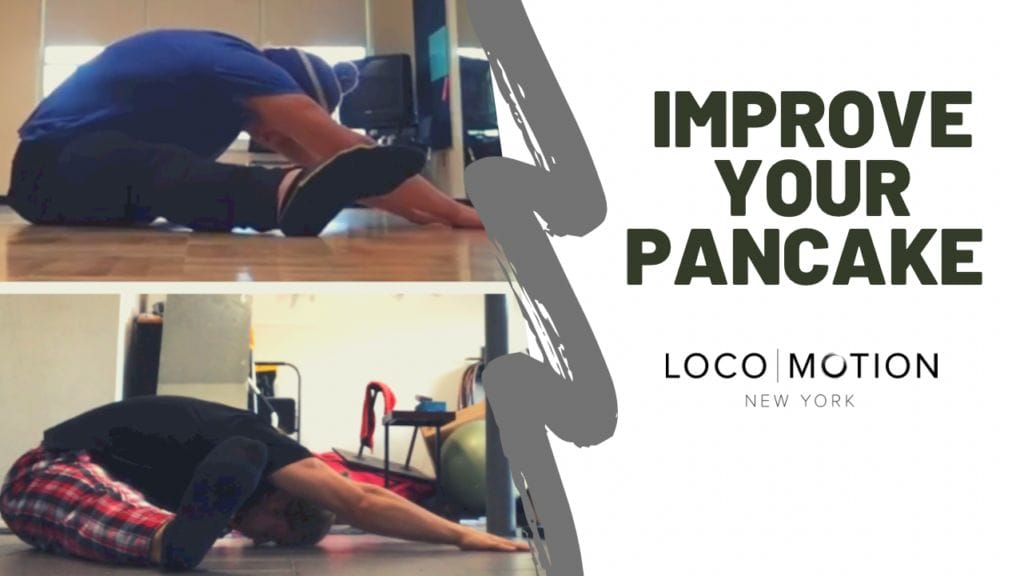In this article, we will discuss some important cues to go along with a recent video we shared on the Pancake Stretch. If children laugh at you when you sit in this position, keep reading.
First, feel free to watch the video here or below.
We will cover some additional cueing for the positions and address some of the nuances of the exercises. Keep in mind, anatomy of the individual differs greatly and while there is generally room for improvement, your positions may not look exactly like mine, and vice versa.
The 3 exercises discussed in the video are as follow:
-
Loaded Pancake (Eccentric, Isometric, & Concentric actions)
-
Pancake Pulses (Active end-range contractions)
-
Pancake Slides (Eccentric, Isometric & Concentric actions)
Loaded Pancake:
The intention in the loaded pancake is to LOAD the eccentric motion of the pancake (hip flexion + abduction) so that the hamstrings and adductors allow for more range of motion and the hip. It also has the benefit of strengthening the concentric motion, pushing your body OUT of the deep pancake, building strength and confidence to move in and out of the position freely. It is very important to move slowly & continue breathing during the eccentric portion. However; make no mistake, this is a strength exercise and should be treated and progressed as such. Here are a few cues and guidelines when training this pattern.
-
Focus on anterior tilt of the pelvis (butt-out). A helpful cue is to spread your cheeks (use this cue sparingly with clients) and lead with your belly button out.
-
Pay careful attention to LEAN only from the hips. Moving closer to the floor is NOT a sign of progress if you are rounding your spine to get there. Be mindful of your ego and be patient, considering that these soft tissues take time to adapt & change. Keep a flat or slightly arched back and an anterior tilt when you lower towards the floor.
-
Contract the quadriceps to pull yourself into the motion, and drive the heels down to push yourself out of the movement to engage the hamstrings for maximal effectiveness. Range of motion improvements are all about intention.
-
Elevate your butt as needed to maintain a perfect anterior pelvic tilt when starting. A video on pancake progressions is shown here.
Pancake Pulses
These are everyones favorite exercise to hate, and for good reason. You will experience hip and quad cramps that reach deep into your soul and test your true will & determination to improve. That being said, I would be hard pressed to find a better exercise to complement the loaded pancakes. Here are a few cues.
-
Aim to maintain your forward lean (i.e. do not lean back). In order for compression work to be effective, well, you need to compress. Leaning back will change the relative angle of the hip flexion and you won’t get the desired result.
-
Contract every fiber on the top of your leg, through your calves & feet. Lock in the tension by locking knees & pointing toes to take out all slack in the system. Your leg becomes a long lever and your hip flexors need to do the very challenging work of lifting your entire leg. It is a difficult job, especially if you have thunder thighs like myself. I was built to carry & move things, but here I am trying to be a gymnast…
-
Lift as high as you can, then a bit higher. There is always more juice to squeeze. If you feel the cramp coming on, you are searching in the right spots.
Pancake Slides
I love pancake slides because they tie the pieces together and grease the groove of the movement. There is the active contraction of the slide, and then the tremendous strength of the posterior chain to push you UP out of the pancake through the heels driving into the floor. Nothing solidifies the range more in my opinion. A few cues for the slides:
-
Use a target for the hands, like a block as shown in the video. This helps keep you honest and gives you feedback rep to rep, set to set. Range should generally improve each rep & set until fatigue begins to set in. Avoid using momentum to “cheat” and pretend you have better range than you do…we all see you.
-
Tie in your breath. I like to use a deep exhale at the end of the range, and then take 1 more full inhale-exhale cycle to build confidence in the ROM.
-
Squeeze quads “up” on the way down. Imagine you are trying to do the pulse exercise from earlier as you lower your body. You won’t be able to, but the effort will help pull you deeper into the stretch, and then you will drive heels “down” into the floor as you extend through the spine and return to a tall seated position.
So, there you have it. In the beginning, focus on the quality and consistency over the exercises over everything else. Do as many or as few reps as you feel comfortable doing. You can stop before you reach fatigue, or once you reach fatigue, which will be marked by either a stagnation or a decrease in your range of motion. Pushing past this point or doing more volume will only lead to an increased risk of injury and not increase rate of improvement.
Questions? Thoughts? Experiences you would like to share? Please feel free to expand below in the comments section below. As always, if you would prefer guidance in your physical practice, feel free to book a call with us at the link below so we can chat about your goals and help you dramatically reduce your time to results.
Happy Training!
– Kevin

